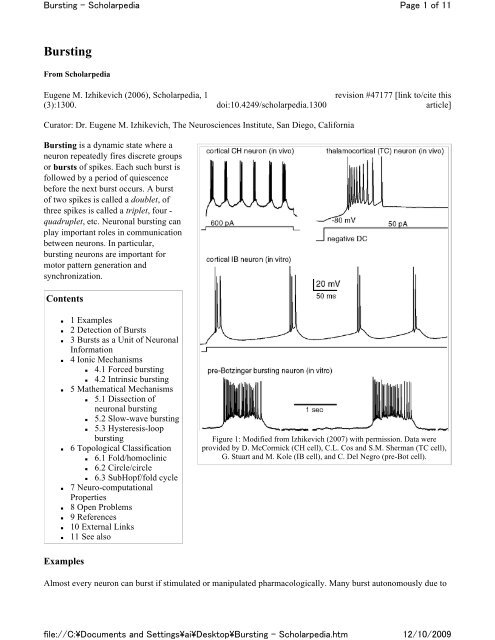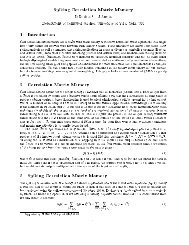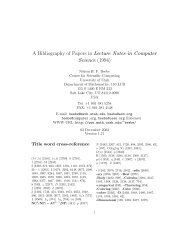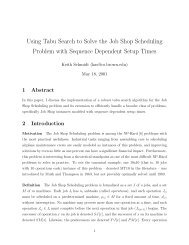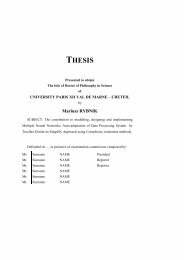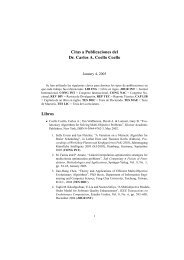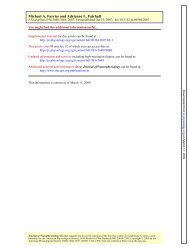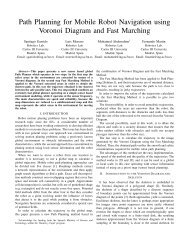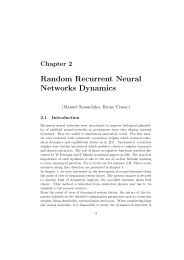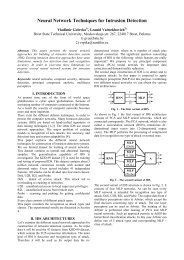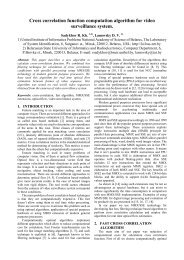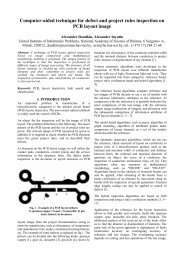Bursting - BSTU Laboratory of Artificial Neural Networks
Bursting - BSTU Laboratory of Artificial Neural Networks
Bursting - BSTU Laboratory of Artificial Neural Networks
You also want an ePaper? Increase the reach of your titles
YUMPU automatically turns print PDFs into web optimized ePapers that Google loves.
<strong>Bursting</strong> - Scholarpedia<br />
<strong>Bursting</strong><br />
From Scholarpedia<br />
Eugene M. Izhikevich (2006), Scholarpedia, 1<br />
(3):1300. doi:10.4249/scholarpedia.1300<br />
Curator: Dr. Eugene M. Izhikevich, The Neurosciences Institute, San Diego, California<br />
<strong>Bursting</strong> is a dynamic state where a<br />
neuron repeatedly fires discrete groups<br />
or bursts <strong>of</strong> spikes. Each such burst is<br />
followed by a period <strong>of</strong> quiescence<br />
before the next burst occurs. A burst<br />
<strong>of</strong> two spikes is called a doublet, <strong>of</strong><br />
three spikes is called a triplet, four -<br />
quadruplet, etc. Neuronal bursting can<br />
play important roles in communication<br />
between neurons. In particular,<br />
bursting neurons are important for<br />
motor pattern generation and<br />
synchronization.<br />
Contents<br />
1 Examples<br />
2 Detection <strong>of</strong> Bursts<br />
3 Bursts as a Unit <strong>of</strong> Neuronal<br />
Information<br />
4 Ionic Mechanisms<br />
4.1 Forced bursting<br />
4.2 Intrinsic bursting<br />
5 Mathematical Mechanisms<br />
5.1 Dissection <strong>of</strong><br />
neuronal bursting<br />
5.2 Slow-wave bursting<br />
5.3 Hysteresis-loop<br />
bursting<br />
6 Topological Classification<br />
6.1 Fold/homoclinic<br />
6.2 Circle/circle<br />
6.3 SubHopf/fold cycle<br />
7 Neuro-computational<br />
Properties<br />
8 Open Problems<br />
9 References<br />
10 External Links<br />
11 See also<br />
Examples<br />
Page 1 <strong>of</strong> 11<br />
revision #47177 [link to/cite this<br />
article]<br />
Figure 1: Modified from Izhikevich (2007) with permission. Data were<br />
provided by D. McCormick (CH cell), C.L. Cos and S.M. Sherman (TC cell),<br />
G. Stuart and M. Kole (IB cell), and C. Del Negro (pre-Bot cell).<br />
Almost every neuron can burst if stimulated or manipulated pharmacologically. Many burst autonomously due to<br />
file://C:\Documents and Settings\ai\Desktop\<strong>Bursting</strong> - Scholarpedia.htm<br />
12/10/2009
<strong>Bursting</strong> - Scholarpedia<br />
the interplay <strong>of</strong> fast ionic currents responsible for spiking activity and slower currents that modulate the activity.<br />
Below is the list <strong>of</strong> the more "famous" bursting neurons.<br />
Neocortex<br />
IB: Intrinsically bursting neurons, if stimulated with a long pulse <strong>of</strong> dc current, fire an initial burst <strong>of</strong><br />
spikes followed by shorter bursts, and then tonic spikes (Connors and Gutnick 1990). These are<br />
predominantly pyramidal neurons in layer 5.<br />
CH: Chattering neurons can fire high-frequency bursts <strong>of</strong> 3-5 spikes with a relatively short interburst<br />
period (Gray and McCormick 1996). Some call them fast rhythmic bursting (FRB) cells. These are<br />
pyramidal neurons in layer 2-4, mainly layer 3.<br />
Interneurons: Some cortical interneurons exhibit bursting activity in response to pulses <strong>of</strong> dc current<br />
(Markram et al. 2004).<br />
Hippocampus<br />
LTB: Low-threshold bursters fire high-frequency bursts in response to injected pulses <strong>of</strong> current.<br />
Some <strong>of</strong> these neurons burst spontaneously (Su et al. 2001). These are pyramidal neurons in CA1<br />
region.<br />
HTB: High-threshold bursters fire bursters only in response to strong long pulses <strong>of</strong> current.<br />
Thalamus<br />
TC: Thalamocortical neurons can fire bursts if inhibited and then released from inhibition. This<br />
rebound burst is <strong>of</strong>ten called a low-threshold spike. Some fire bursts spontaneously in response to<br />
tonic inhibition.<br />
RTN: Reticular thalamic nucleus inhibitory neurons have bursting properties similar to those <strong>of</strong> TC<br />
cells.<br />
Cerebellum<br />
PC: Purkinje cells in cerebellar slices usually fire tonically but when synaptic input is blocked they<br />
can switch to a trimodal pattern which includes a bursting phase (Womack and Khodakhah 2002).<br />
Other<br />
structures<br />
pre-<br />
Bot:<br />
Respiratory neurons in pre-Botzinger complex fire rhythmic bursts that control animal respiration<br />
cycle.<br />
MesV: Some Mesencephalic V neurons in brainstem may fire rhythmic bursts when slightly<br />
depolarized above the threshold.<br />
AB: Anterior bursting neuron in lobster stomatogastric ganglion fires rhythmic bursts<br />
autonomously.<br />
R15: Aplysia abdominal ganglion neuron R15 fires autonomous rhythmic bursts.<br />
β-cell: Pancreatic β-cells fire rhythmic bursts that control the secretion <strong>of</strong> insulin.<br />
Sometimes the term bursting is used in reference to the bursting pacemaker potential itself and not just the burst<br />
<strong>of</strong> spikes. So, in the literature, one might see references to bursts in the presence <strong>of</strong> TTX. There are also examples<br />
<strong>of</strong> one spike bursts such as in the CPGs for swimming in Clione and in Xenopus tadpoles.<br />
Detection <strong>of</strong> Bursts<br />
file://C:\Documents and Settings\ai\Desktop\<strong>Bursting</strong> - Scholarpedia.htm<br />
Page 2 <strong>of</strong> 11<br />
12/10/2009
<strong>Bursting</strong> - Scholarpedia<br />
It is relatively easy to identify bursts in response to simple stimuli, such as dc steps or sine waves, especially if<br />
recording intracellularly from a quiet in vitro slice. The bursts fully evolve and the hallmarks <strong>of</strong> burst responses<br />
are clear. However, responses to sensory stimuli are <strong>of</strong>ten comprised <strong>of</strong> doublets or triplets embedded in spike<br />
trains. Furthermore, these responses are usually recorded extracellularly so the experimenter does not have access<br />
to the membrane potential fluctuations that are indicative <strong>of</strong> bursting. Thus, it is difficult to distinguish burst<br />
responses from random multispike events.<br />
Figure 2: Interspike interval histograms <strong>of</strong> two model neurons with simulated strong in vivo input<br />
The statistical analysis <strong>of</strong> spike trains addresses this problem. Bimodal inter-spike interval (ISI) histograms can be<br />
indicative <strong>of</strong> burst responses. The rationale is that short ISIs occur more frequently when induced by burst<br />
dynamics than would occur if predicted by Poisson firing. Burst spikes with short ISIs form the first mode while<br />
quiescent periods correspond to the longer ISIs <strong>of</strong> the second mode. This is true for intrinsic or forced (stimulus<br />
driven and network-induced) bursting. Furthermore, the trough between the two modes may correspond to the<br />
refractory period <strong>of</strong> an intrinsic burst or the timescale <strong>of</strong> the network-induced bursting (Doiron et al. 2003). This<br />
method defines a criterion for burst identification so that further analysis and experimentation can determine the<br />
mechanism and function <strong>of</strong> the bursts. See Holt et al., (1996) and Bastian and Nguyenkim (2001) for a deeper<br />
analysis into burst detection from stochastic spike data.<br />
Bursts as a Unit <strong>of</strong> Neuronal Information<br />
There are many hypotheses on the importance <strong>of</strong> bursting activity in neural computation.<br />
Page 3 <strong>of</strong> 11<br />
Bursts are more reliable than single spikes in evoking responses in postsynaptic cells. Indeed, excitatory<br />
post-synaptic potentials (EPSP) from each spike in a burst add up and may result in a superthreshold EPSP.<br />
Bursts overcome synaptic transmission failure. Indeed, postsynaptic responses to a single presynaptic<br />
spike may fail (release does not occur), however in response to a bombardment <strong>of</strong> spikes, i.e., a burst,<br />
synaptic release is more likely (Lisman 1997).<br />
Bursts facilitate transmitter release whereas single spikes do not (Lisman 1997). Indeed, a synapse with<br />
strong short-term facilitation would be insensitive to single spikes or even short bursts, but not to longer<br />
bursts. Each spike in the longer burst facilitates the synapse so the effect <strong>of</strong> the last few spikes may be quite<br />
strong.<br />
Bursts evoke long-term potentiation and hence affect synaptic plasticity much greater, or differently than<br />
single spikes (Lisman 1997).<br />
file://C:\Documents and Settings\ai\Desktop\<strong>Bursting</strong> - Scholarpedia.htm<br />
12/10/2009
<strong>Bursting</strong> - Scholarpedia<br />
Bursts have higher signal-to-noise ratio than single spikes (Sherman 2001). Indeed, burst threshold is<br />
higher than spike threshold, i.e., generation <strong>of</strong> bursts requires stronger inputs.<br />
Bursts can be used for selective communication if the postsynaptic cells have subthreshold oscillations<br />
<strong>of</strong> membrane potential. Such cells are sensitive to the frequency content <strong>of</strong> the input. Some bursts resonate<br />
with oscillations and elicit a response, others do not, depending on the interburst frequency (Izhikevich et<br />
al. 2003).<br />
Bursts can resonate with short-term synaptic plasticity making a synapse a band-pass filter (Izhikevich<br />
et al. 2003). A synapse having short-term facilitation and depression is most sensitive to a burst having<br />
certain resonant interspike frequency. Such a burst evokes just enough facilitation, but not too much<br />
synaptic depression, so its effect on the postsynaptic target is maximal.<br />
Bursts encode different features <strong>of</strong> sensory input than single spikes (Gabbiani et al. 1996, Oswald et al.<br />
2004). For example, neurons in the electrosensory lateral-line lobe (ELL) <strong>of</strong> weakly electric fish fire<br />
network induced-bursts in response to communication signals and single spikes in response to prey signals<br />
(Doiron et al. 2003). In the thalamus <strong>of</strong> the visual system bursts from pyramidal neurons encode stimuli<br />
that inhibit the neuron for a period <strong>of</strong> time and then rapidly excite the neuron (Lesica and Stanely, 2004).<br />
Natural scenes are <strong>of</strong>ten composed <strong>of</strong> such events.<br />
Bursts have more informational content than single spikes when analyzed as unitary events (Reinagel<br />
et al. 1999). This information may be encoded into the burst duration or in the fine temporal structure <strong>of</strong><br />
interspike intervals within a burst.<br />
In summary, burst input is more likely to have a stronger impact on the postsynaptic cell than single spike input,<br />
so some believe that bursts are all-or-none events, whereas single spikes may be noise.<br />
Ionic Mechanisms<br />
Forced bursting<br />
Most spiking neurons can burst<br />
if stimulated with a current that<br />
slowly drives the neuron above<br />
and below the firing threshold.<br />
Such a current could be<br />
injected via an electrode or<br />
generated by the synaptic input.<br />
Below are some examples <strong>of</strong><br />
forced bursters.<br />
RA neurons in the songbird burst in response to drive from HVC neurons. The bursting arises as a result <strong>of</strong><br />
either network dynamics within RA or is inherited from HVC (see review by Fee et al. 2004).<br />
Network induced bursts <strong>of</strong> electric fish (Doiron et al. 2003). Here bursting arises because periodic<br />
inhibitory inputs reduce firing and create intervals <strong>of</strong> quiescence.<br />
Electroreceptor afferents in paddlefish. <strong>Bursting</strong> occurs because <strong>of</strong> a pre-filtering <strong>of</strong> broadband stochastic<br />
stimuli that drives the receptors. The receptor dynamics can be modeled as a simple excitable system and<br />
the slow noise (filtered) pushes the neuron into periods <strong>of</strong> rapid firing and into periods <strong>of</strong> quiescence<br />
(Neiman and Russell, 2002).<br />
Intrinsic bursting<br />
Figure 3: Forced bursting in response to injected input<br />
Page 4 <strong>of</strong> 11<br />
Many neurons have slow intrinsic membrane currents that can modulate fast spiking activity. Typically, the<br />
currents build up during continuous spiking, hyperpolarize the cell and result in the termination <strong>of</strong> the spike train.<br />
While the cell is quiescent, the currents slowly decay, the cell recovers, and it is ready to fire another burst.<br />
Much experimental research is aimed at identifying these slow currents, so that bursting can be manipulated. To<br />
file://C:\Documents and Settings\ai\Desktop\<strong>Bursting</strong> - Scholarpedia.htm<br />
12/10/2009
<strong>Bursting</strong> - Scholarpedia<br />
produce an inhibitory effect, i.e., to stop the burst, spiking activity should either<br />
activate (turn on) an outward current, e.g., persistent K + current, or<br />
inactivate (turn <strong>of</strong>f) an inward current, e.g., transient Ca 2+ current.<br />
Such action can be either<br />
voltage-gated or<br />
Ca 2+ -gated.<br />
Hence there are at least four different theoretical<br />
mechanisms <strong>of</strong> modulation <strong>of</strong> spiking; see table.<br />
All four mechanisms have been documented in vitro. For example,<br />
neocortical pyramidal neurons exhibiting chattering activity have<br />
voltage-gated K + M-current (Wang 1999). Midbrain dopaminergic<br />
neurons have Ca 2+ -gated K + current K Ca (Amini et al. 1999). In<br />
both cases, continuous spiking activates the outward K + currents<br />
and results in burst termination. Thalamic relay neurons have<br />
voltage-gated Ca 2+ T-current (Huguenard and McCormick 1992).<br />
Anterior bursting (AB) neurons in lobster stomatogastric ganglion<br />
have Ca 2+ -gated Ca 2+ -current, called L-current (Harris-Warrick<br />
and Flamm 1987). In both cases, continuous spiking inactivates the<br />
inward Ca 2+ currents and also results in burst termination. Many<br />
neurons have a mixture <strong>of</strong> mechanisms described in the table. In all<br />
these cases, the interspike intervals within the burst is typically<br />
increasing.<br />
In addition, bursting can result from the somatic-dendritic<br />
interplay: Somatic spike excites dendritic tree resulting in a<br />
delayed spike there. Dendritic spike depolarizes the soma and<br />
evokes another somatic spike, which results in another dendritic<br />
spike, and so forth. The interspike intervals <strong>of</strong> the burst is typically<br />
decreasing up to the point when a somatic spike falls into the<br />
refractory period <strong>of</strong> the dendritic spike, fails to evoke dendritic<br />
response, and stops the burst (Doiron et al. 2002).<br />
Mathematical Mechanisms<br />
Different ionic mechanisms <strong>of</strong> bursting may result in different mathematical mechanisms, which in turn determine<br />
the neuro-computational properties <strong>of</strong> bursters, i.e., how they respond to the input. Therefore, much effort is<br />
devoted to study and classify the dynamics <strong>of</strong> bursting, as reviewed in detail by Coombes and Bressl<strong>of</strong>f (2005)<br />
and Izhikevich (2007).<br />
Most mathematical models <strong>of</strong> bursters can be written in the fast-slow form<br />
Page 5 <strong>of</strong> 11<br />
Examples <strong>of</strong> currents that modulate spiking<br />
voltage-gated Ca 2+ -gated<br />
activation <strong>of</strong> outward M-current AHP-current<br />
inactivation <strong>of</strong> inward Ca 2+ T-current Ca 2+ L-current<br />
Figure 4: <strong>Bursting</strong> can be with increasing or<br />
decreasing interspike intervals (ISI).<br />
Modified from Izhikevich (2007) with<br />
permission.<br />
where vector describes the state <strong>of</strong> the fast subsystem responsible for spiking activity, vector describes the<br />
file://C:\Documents and Settings\ai\Desktop\<strong>Bursting</strong> - Scholarpedia.htm<br />
12/10/2009
<strong>Bursting</strong> - Scholarpedia<br />
state <strong>of</strong> the slow subsystem that modulates spiking, and are some Hodgkin-Huxley-type functions, and<br />
is the ratio <strong>of</strong> time scales.<br />
Dissection <strong>of</strong> neuronal bursting<br />
A standard method <strong>of</strong> analysis <strong>of</strong> fast-slow bursters, as well as <strong>of</strong> any singularly perturbed system, is to set<br />
and consider the fast and the slow subsystems separately. This is known as dissection <strong>of</strong> neuronal<br />
bursting (Rinzel 1985), since it allows us to study the fast subsystem<br />
and treat as a vector <strong>of</strong> slowly changing bifurcation parameters. Typically, the fast subsystem has a limit cycle<br />
(spiking) attractor for some values <strong>of</strong> and an equilibrium (resting) attractor for other values <strong>of</strong> . As the slow<br />
variable oscillates between the two values, the fast subsystem, and hence the whole system, burst.<br />
Slow-wave bursting<br />
What makes the slow variable oscillate? In the simplest case, the slow subsystem may have a limit<br />
cycle attractor, which is relatively insensitive to the value <strong>of</strong> the fast variable. In this case, the slow variable<br />
exhibits an autonomous oscillation that periodically drives the fast subsystem over the threshold. Such a bursting<br />
is called slow-wave bursting. The slow subsystem must be at least two-dimensional to exhibit slow-wave<br />
bursting.<br />
Slow-wave bursting in conductance-based models is usually more interesting than the simplest case described<br />
above. In such models, the slow subsystem <strong>of</strong>ten consists <strong>of</strong> activation and inactivation gates <strong>of</strong> slow currents. For<br />
example, with<br />
Obviously, such a slow subsystem is uncoupled for any fixed value <strong>of</strong> the fast variable, i.e., in the voltage clamp (<br />
). Yet, it can still have a limit cycle attractor if the fast variable is allowed to evolve, i.e., the<br />
membrane potential is allowed to spike.<br />
Hysteresis-loop bursting<br />
When the equilibrium and limit cycle<br />
attractors <strong>of</strong> the fast subsystem coexits<br />
for the same value <strong>of</strong> , there is<br />
a bistability <strong>of</strong> resting and spiking<br />
states. This creates a hysteresis loop<br />
for the slow variable and such a<br />
bursting is called hysteresis-loop<br />
bursting. The slow variable may<br />
be one-dimensional in this case,<br />
oscillating between resting and<br />
spiking values via the hysteresis<br />
loop.<br />
Page 6 <strong>of</strong> 11<br />
Figure 5: Hysteresis-loop bursting (modified from Izhikevich (2007) with<br />
permissions).<br />
file://C:\Documents and Settings\ai\Desktop\<strong>Bursting</strong> - Scholarpedia.htm<br />
12/10/2009
<strong>Bursting</strong> - Scholarpedia<br />
When the fast variable is in the spiking state, the slow variable, governed by the equation , is<br />
pushed toward the region <strong>of</strong> quiescence (resting, rightward in the figure), and spiking abruptly stops. When the<br />
fast variable is quiescent, the slow variable is pushed toward the region <strong>of</strong> spiking (leftward in the figure) and<br />
after a while spiking abruptly starts. These transitions from spiking to resting and back correspond to bifurcations<br />
<strong>of</strong> the fast subsystem.<br />
Topological Classification<br />
At first glance,<br />
all bursters<br />
look the same -<br />
clusters <strong>of</strong><br />
spikes<br />
separated by<br />
long periods <strong>of</strong><br />
quiescence. A<br />
closer look<br />
reveals that<br />
bursters may be<br />
different<br />
quantitatively,<br />
but are they<br />
different<br />
qualitatively?<br />
Page 7 <strong>of</strong> 11<br />
Bursters are<br />
distinguished<br />
qualitatively<br />
according to<br />
their<br />
topological<br />
type. There are Figure 6: Topological classification <strong>of</strong> fast-slow bursters having two-dimensional fast (spiking)<br />
two important<br />
subsystem. Reproduced from Izhikevich (2007) with permission.<br />
bifurcations <strong>of</strong><br />
the fast<br />
subsystem that determine the topological type:<br />
resting to spiking: Bifurcation <strong>of</strong> a stable equilibrium (resting) that results in the transition to limit cycle<br />
attractor (spiking).<br />
spiking to resting: Bifurcation <strong>of</strong> a limit cycle attractor that results in the transition to the equilibrium<br />
(resting).<br />
There are only 4 possible bifurcations <strong>of</strong> co-dimension 1 <strong>of</strong> equilibrium, depicted in the first column in the figure.<br />
If the fast subsystem is two-dimensional, then there are only 4 possible bifurcations <strong>of</strong> co-dimension 1 <strong>of</strong> a limit<br />
cycle attractor, depicted in the first row <strong>of</strong> the figure. Hence, there are 16 different combinations, resulting in 16<br />
different topological types <strong>of</strong> fast-slow bursters with 2-dimensional fast subsystems. They are named after the<br />
bifurcations involved.<br />
The classification <strong>of</strong> bursters according to the bifurcations <strong>of</strong> the fast subsystem was first suggested by Rinzel<br />
(1987), who identified three types presented below. It was later extended by Bertram et al. (1995), who included<br />
file://C:\Documents and Settings\ai\Desktop\<strong>Bursting</strong> - Scholarpedia.htm<br />
12/10/2009
<strong>Bursting</strong> - Scholarpedia<br />
another type. Izhikevich (2000) provided the complete classification, identifying all 16 topological types in the<br />
figure, and 120 all possible types if the constraint that the fast subsystem is two-dimensional is removed. Burst<br />
mechanisms can also be classified via unfolding <strong>of</strong> a higher co-dimension bifurcation <strong>of</strong> the fast subsystem<br />
(Golubitsky et al. 2001).<br />
Fold/homoclinic<br />
Probably the most frequent type <strong>of</strong><br />
bursting encountered in simulations<br />
is the fold/homoclinic type, also<br />
known as square-wave bursting,<br />
because the burst pr<strong>of</strong>ile sometimes<br />
looks like a square. While the slow<br />
variable moves to the left along the<br />
lower (resting) branch in the 3D<br />
phase portrait in the figure, the fast<br />
subsystem undergoes fold (saddle-node <strong>of</strong>f limit cycle) bifurcation resulting in the transition from resting to<br />
spiking. As it spikes, the slow variable moves to the right along the cylinder corresponding to spiking state, the<br />
fast subsystem undergoes saddle homoclinic orbit bifurcation resulting in the transition from spiking to resting.<br />
The slow variable starts to move to the left again, thereby closing the hysteresis loop.<br />
This type <strong>of</strong> bursting has been reported in many cells and cell models, including pancreatic β-cells, cells in the<br />
pre-Botzinger complex, intrinsically bursting and chattering neurons in neocortex.<br />
Circle/circle<br />
This type <strong>of</strong> bursting is a prominent feature <strong>of</strong> R15 cells in the abdominal ganglion <strong>of</strong> the mollusk Aplysia. It was<br />
called parabolic because the frequency pr<strong>of</strong>ile within a burst looks like a parabola. The transition from spiking to<br />
resting and back to spiking <strong>of</strong> the fast subsystem occurs via saddle-node on invariant circle bifurcation. The slow<br />
subsystem <strong>of</strong> circle/circle bursters is usually (but not necessary) two-dimensional or higher exhibiting an<br />
autonomous slow-wave oscillation that drives periodically the fast subsystem over the threshold.<br />
SubHopf/fold cycle<br />
Page 8 <strong>of</strong> 11<br />
This type <strong>of</strong> bursting is also<br />
called elliptic because the<br />
amplitude pr<strong>of</strong>ile <strong>of</strong> the burst<br />
sometimes looks like an<br />
ellipse. A three-dimensional<br />
phase portrait <strong>of</strong> the burster<br />
is depicted in the figure from<br />
two different points <strong>of</strong> view.<br />
While the fast subsystem<br />
Figure 8: SubHopf/fold cycle bursting.<br />
exhibits spiking oscillations<br />
(the outer cylinder), the slow<br />
variable moves to the left and the spiking stops via fold limit cycle bifurcation. While the fast subsystem is<br />
resting, the slow variable moves along the center axis to the right and the spiking starts via subcritical Andronov-<br />
Hopf bifurcation, thereby closing the hysteresis loop.<br />
This type <strong>of</strong> bursting has been reported in rodent trigeminal interneurons, dorsal root ganglion, and mesencephalic<br />
file://C:\Documents and Settings\ai\Desktop\<strong>Bursting</strong> - Scholarpedia.htm<br />
12/10/2009
<strong>Bursting</strong> - Scholarpedia<br />
V cells <strong>of</strong> the brainstem.<br />
Neuro-computational Properties<br />
Mathematical studies <strong>of</strong> bursters revealed that different topological types have different neuro-computational<br />
properties (Izhikevich 2007):<br />
Bursters that involve Andronov-Hopf bifurcation (Hopf/* and subHopf/*) act as resonators, i.e., they are<br />
sensitive to the frequency content <strong>of</strong> the synaptic input. In contrast, the other types (fold/* and circle/*) act<br />
as integrators.<br />
Bursters that involve fold, subcritical Andronov-Hopf, saddle homoclinic orbit, and fold limit cycle<br />
bifurcations have co-existence <strong>of</strong> resting and spiking states, and hence have a bistable or Multistable<br />
dynamics. An appropriately timed input can switch bursting activity from spiking to quiescence and back.<br />
The input does not even have to be excitatory.<br />
Different topological types <strong>of</strong> bursters have different synchronization properties. Some tend to synchronize<br />
in-phase, others tend to de-synchronize.<br />
Open Problems<br />
The complete classification <strong>of</strong> all electrophysiological types <strong>of</strong> bursters is still missing.<br />
There is no methodology <strong>of</strong> how to distinguish different topological types experimentally.<br />
The relationship between electrophysiology <strong>of</strong> a cell and the topological type <strong>of</strong> its bursting is not worked<br />
out.<br />
It is not fully understood how synchronization properties <strong>of</strong> bursters depend on their topological types.<br />
There is no complete classification <strong>of</strong> all possible transitions between rhythmic bursting and tonic spiking,<br />
and rhythmic bursting and total quiescence. That is, what are the bifurcation mechanisms <strong>of</strong> appearance<br />
and disappearance <strong>of</strong> bursting oscillations? (see also Routes into <strong>Bursting</strong>).<br />
Mathematical theory suitable to study bursting activity is not fully developed yet. Most asymptotic<br />
methods break down when transitions between limit cycles are considered.<br />
Development <strong>of</strong> early dynamical systems theory was influenced by the studies <strong>of</strong> oscillators. It is reasonable to<br />
expect that the next major developments <strong>of</strong> the theory would be coming from studies <strong>of</strong> bursting dynamics.<br />
References<br />
Page 9 <strong>of</strong> 11<br />
Amini, B., Clark J. W. Jr., and Canavier C. C. (1999) Calcium Dynamics Underlying Pacemaker-Like and<br />
Burst Firing Oscillations in Midbrain Dopaminergic Neurons: A Computational Study. J. Neurophysiol.<br />
82:2249-2261,<br />
Bertram R., Butte M.J., Kiemel T., and Sherman A. (1995) Topological and phenomenological<br />
classification <strong>of</strong> bursting oscillations. Bulletin <strong>of</strong> Mathematical Biology 57:413-439.<br />
Bastian J. and Nguyenkim J. (2001) Dendritic Modulation <strong>of</strong> Burst-Like Firing in Sensory Neurons. J<br />
Neurophysiol, Jan; 85: 10 - 22.<br />
Connors B.W. and Gutnick M.J. (1990) Intrinsic firing patterns <strong>of</strong> diverse neocortical neurons, Trends in<br />
Neuroscience, 13:99-104.<br />
Coombes S. and Bressl<strong>of</strong>f P.C. (editors, 2005) <strong>Bursting</strong>: The Genesis <strong>of</strong> Rhythm in the Nervous System,<br />
World Scientific Press.<br />
Doiron B., Chacron M.J., Maler L., Longtin A., Bastian J. (2003) Inhibitory feedback required for network<br />
oscillatory responses to communication but not prey stimuli. Nature, 421:539-543.<br />
Doiron B., Laing C., Longtin A., and Maler L. (2002) Ghostbursting: a novel neuronal burst mechanism, J.<br />
Comput. Neurosci. 12:5-25.<br />
Fee M.S., Kozhevnikov A.A., Hahnloser R.H. (2004) <strong>Neural</strong> mechanisms <strong>of</strong> vocal sequence generation in<br />
the songbird. Ann. N.Y. Acad. Sci. 1016: 153–170.<br />
Gabbiani F, Metzner W, Wessel R, Koch C. (1996) From stimulus encoding to feature extraction in weakly<br />
file://C:\Documents and Settings\ai\Desktop\<strong>Bursting</strong> - Scholarpedia.htm<br />
12/10/2009
<strong>Bursting</strong> - Scholarpedia<br />
electric fish. Nature. 384(6609):564-567.<br />
Golubitsky M., Josic K., and Kaper T.J., (2001) An Unfolding Theory Approach to <strong>Bursting</strong> in Fast-Slow<br />
Systems chapter in Global Analysis <strong>of</strong> Dynamical Systems, dedicated to Floris Takens.<br />
Gray C.M. and McCormick D.A. (1996) Chattering cells: superficial pyramidal neurons contributing to the<br />
generation <strong>of</strong> synchronous oscillations in the visual cortex. Science. 274 (5284): 109-113<br />
Harris-Warrick R.M. and Flamm R.E. (1987) Multiple mechanisms <strong>of</strong> bursting in a conditional bursting<br />
neuron. J. Neurosci., 7:2113-2128<br />
Holt G.R., S<strong>of</strong>tky W.R., Koch C., and Douglas R.J. (1996) Comparison <strong>of</strong> discharge variability in vitro and<br />
in vivo in cat visual cortex neurons J Neurophysiol, 75: 1806 - 1814.<br />
Huguenard J.R. and McCormick D.A. (1992) Simulation <strong>of</strong> the Currents Involved in Rhythmic Oscillations<br />
in Thalamic Relay Neurons. Journal <strong>of</strong> Neurophysiology, 68:1373-1383<br />
Izhikevich E.M. (2007) Dynamical Systems in Neuroscience: The Geometry <strong>of</strong> Excitability and <strong>Bursting</strong><br />
(http://www.nsi.edu/users/izhikevich/publications/). The MIT Press, Cambridge, MA.<br />
Izhikevich E.M. (2000) <strong>Neural</strong> Excitability, Spiking, and <strong>Bursting</strong><br />
(http://www.nsi.edu/users/izhikevich/publications/nesb.htm). International Journal <strong>of</strong> Bifurcation and<br />
Chaos, 10:1171-1266.<br />
Izhikevich E.M., Desai N.S., Walcott E.C., Hoppensteadt F.C. (2003) Bursts as a unit <strong>of</strong> neural<br />
information: selective communication via resonance<br />
(http://www.nsi.edu/users/izhikevich/publications/tins.htm). Trends in Neuroscience, 26:161-167.<br />
Lisman J. (1997) Bursts as a unit <strong>of</strong> neural information: making unreliable synapses reliable, Trends in<br />
Neuroscience, 20:38-43<br />
Lesica N.A and Stanley G.B. (2004) Encoding <strong>of</strong> Natural Scene Movies by Tonic and Burst Spikes in the<br />
Lateral Geniculate Nucleus, J. Neurosci. 24: 10731 - 10740.<br />
Markram H, Toledo-Rodriguez M, Wang Y, Gupta A, Silberberg G, and Wu C. (2004) Interneurons <strong>of</strong> the<br />
neocortical inhibitory system. Nature Review Neuroscience 5:793-807.<br />
Neiman A.B. and Russell D.F. (2002) Synchronization <strong>of</strong> Noise-Induced Bursts in Noncoupled Sensory<br />
Neurons. Phys. Rev. Lett. 88, 138103.<br />
Oswald A.M., Chacron M.J., Doiron B., Bastian J., Maler L. (2004) Parallel processing <strong>of</strong> sensory input by<br />
bursts and isolated spikes. J Neurosci. 24(18):4351-62.<br />
Reinagel P, Godwin D, Sherman SM, Koch C. (1999) Encoding <strong>of</strong> visual information by LGN bursts. J<br />
Neurophysiol. 81:2558-69.<br />
Rinzel J. (1985) <strong>Bursting</strong> oscillations in an excitable membrane model. In: Sleeman BD, Jarvis RJ, eds.<br />
Ordinary and partial Differential Equations. Proceedings <strong>of</strong> the 8th Dundee Conference. Lecture Notes in<br />
Mathematics, 1151. Berlin: Springer, 304-316.<br />
Sherman S.M. (2001) Tonic and burst firing: dual modes <strong>of</strong> thalamocortical relay, Trends in Neuroscience,<br />
24:122-126.<br />
Su H, Alroy G, Kirson ED, Yaari Y. (2001) Extracellular calcium modulates persistent sodium currentdependent<br />
burst-firing in hippocampal pyramidal neurons. Journal <strong>of</strong> Neuroscience 21:4173-4182.<br />
Wang X.-J. (1999) Fast burst firing and short-term synaptic plasticity: a model <strong>of</strong> neocortical chattering<br />
neurons. Neuroscience, 89:347-362.<br />
Womack M. D., and Khodakhah K. (2002) Active contribution <strong>of</strong> dendrites to the tonic and trimodal<br />
patterns <strong>of</strong> activity in cerebellar Purkinje neurons. J Neurosci. 15;22(24):10603-10612<br />
Internal references<br />
Yuri A. Kuznetsov (2006) Andronov-Hopf bifurcation. Scholarpedia, 1(10):1858.<br />
John W. Milnor (2006) Attractor. Scholarpedia, 1(11):1815.<br />
Frances K. Skinner (2006) Conductance-based models. Scholarpedia, 1(11):1408.<br />
Jeff Moehlis, Kresimir Josic, Eric T. Shea-Brown (2006) Periodic orbit. Scholarpedia, 1(7):1358.<br />
Yuri A. Kuznetsov (2006) Saddle-node bifurcation. Scholarpedia, 1(10):1859.<br />
Don H. Johnson (2006) Signal-to-noise ratio. Scholarpedia, 1(12):2088.<br />
Philip Holmes and Eric T. Shea-Brown (2006) Stability. Scholarpedia, 1(10):1838.<br />
S. Murray Sherman (2006) Thalamus. Scholarpedia, 1(9):1583.<br />
External Links<br />
file://C:\Documents and Settings\ai\Desktop\<strong>Bursting</strong> - Scholarpedia.htm<br />
Page 10 <strong>of</strong> 11<br />
12/10/2009
<strong>Bursting</strong> - Scholarpedia<br />
Author’s website (http://www.izhikevich.com/)<br />
<strong>Bursting</strong> (http://en.wikipedia.org/wiki/<strong>Bursting</strong>) in Wikipedia<br />
See also<br />
Bifurcations, Bistability, Burst Synchronization, Multi-stability in Neuronal Models, Neuronal Excitability,<br />
Routes into <strong>Bursting</strong>, Stability, Stomatogastric Ganglion<br />
Eugene M. Izhikevich (2006) <strong>Bursting</strong>. Scholarpedia, 1(3):1300, (go to the first approved version)<br />
Created: 8 February 2006, reviewed: 3 March 2006, accepted: 5 March 2006<br />
Retrieved from "http://www.scholarpedia.org/article/<strong>Bursting</strong>"<br />
Categories: Electrophysiology | Oscillators | Bifurcation Theory | Computational Neuroscience | Neuroscience |<br />
Dynamical Systems | Bifurcations<br />
This page was last modified 02:04, 10 September 2008.<br />
[4 watching user/s]<br />
Copyright (C)<br />
ISSN 1941-6016<br />
Served in 0.166 sec.<br />
file://C:\Documents and Settings\ai\Desktop\<strong>Bursting</strong> - Scholarpedia.htm<br />
Page 11 <strong>of</strong> 11<br />
12/10/2009


